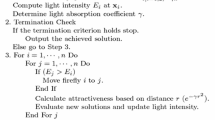Abstract
As the world gradually transforms from an information world to a data-driven world, areas of pattern recognition and data mining are facing more and more challenges. The process of feature subset selection becomes a necessary part of big data pattern recognition due to the data with explosive growth. Inspired by the behavior of grabbing resources in animals, this paper adds personal grabbing-resource behavior into the model of resource allocation transformed from the model of feature selection. Multi-colony fairness algorithm (MCFA) is proposed to deal with grabbing-resource behaviors in order to obtain a better distribution scheme (i.e., to obtain a better feature subset). The algorithm effectively fuses strategies of the random search and the heuristic search. In addition, it combines methods of filter and wrapper so as to reduce the amount of calculation while improving classification accuracies. The convergence and the effectiveness of the proposed algorithm are verified both from mathematical and experimental aspects. MCFA is compared with other four classic feature selection algorithms such as sequential forward selection, sequential backward selection, sequential floating forward selection, and sequential floating backward selection and three mainstream feature selection algorithms such as relevance–redundancy feature selection, minimal redundancy–maximal relevance, and ReliefF. The comparison results show that the proposed algorithm can obtain better feature subsets both in the aspects of feature subset length which is defined as the number of features in a feature subset and the classification accuracy. The two aspects indicate the efficiency and the effectiveness of the proposed algorithm.











Similar content being viewed by others
References
Averell L, Heathcote A (2011) The form of the forgetting curve and the fate of memories. J Math Psychol 55(1):25–35
Azar AT, Elshazly HI, Hassanien AE et al (2014) A random forest classifier for lymph diseases. Comput Methods Programs Biomed 113(2):465–473
Bouatmane S, Roula MA, Bouridane A et al (2011) Round-robin sequential forward selection algorithm for prostate cancer classification and diagnosis using multispectral imagery. Mach Vis Appl 22:865–878
Demsar J (2006) Statistical comparisons of classifiers over multiple data sets. J Mach Learn Res 7:1–30
Feng X, Yang T, Li S (2015) Network behavior-oriented CDN cache allocation strategy. Comput Sci 42:156–161
Gan JQ, Hasan BAS, Tsui CSL (2014) A filter-dominating hybrid sequential forward floating search method for feature subset selection in high-dimensional space. Int J Mach Learn Cybern 5:413–423
Garcia S, Molina D, Lozano M et al (2009) A study on the use of non-parametric tests for analyzing the evolutionary algorithms behaviour: a case study on the CEC2005 special session on real parameter optimization. J Heuristics 15:617–644
Glten A (2013) Genetic algorithm wrapped bayesian network feature selection applied to differential diagnosis of erythemato-squamous diseases. Digit Signal Proc 23(1):230–237
Guyon I (2003) An introduction to variable and feature selection. J Mach Learn Res 3:1157–1182
Han XH, Chang XM, Quan L et al (2014) Feature subset selection by gravitational search algorithm optimization. Inf Sci 281:128–146
Herzfeld DJ, Vaswani PA, Marko MK et al (2014) A memory of errors in sensorimotor learning. Science 345(6202):1349–1353
Juanying X, Weixin X (2014) Several feature selection algorithms based on the discernibility of a feature subset and support vector machines. Chin J Comput 37(8):1704–1718
Linksvayer T (2014) Evolutionary biology: Survival of the fittest group. Nature 514(7522):308–309
Mar T, Zaunseder S, Martinez JP et al (2011) Optimization of ECG classification by means of feature selection. IEEE Trans Biomed Eng 58(8):2168–2177
Mersch DP, Crespi A, Keller L (2013) Tracking individuals shows spatial fidelity is a key regulator of ant social organization. Science 340(6136):1090–1093
Moradi P, Rostami M (2015) Integration of graph clustering with ant colony optimization for feature selection. Knowl Based Syst 84:144–161
Nemati S, Basiri ME (2011) Text-independent speaker verification using ant colony optimization-based selected features. Expert Syst Appl 38(1):620–630
Parkka J, Ermes M, van Gils M (2010) Automatic feature selection and classification of physical and mental load using data from wearable sensors. IEEE, Washington
Peng H, Yinlian F, Liu J et al (2013) Optimal gene subset selection using the modified SFFS algorithm for tumor classification. Neural Comput Appl 23:1531–1538
Peter C, Jessica JK (2008) The interaction between predation and competition. Nature 456(7219):235–238
Uzer MS, Inan O, Yilmaz N (2013) A hybrid breast cancer detection system via neural network and feature selection based on sbs, sfs and pca. Neural Comput Appl 23:719–728
Vergara JR, Estevez PA (2014) A review of feature selection methods based on mutual information. Neural Comput Appl 24:175–186
Xiaofeng M, Yong L, Jianhua Z (2013) Social computing in the era of big data: opportunities and challenges. J Comput Res Dev 50(12):2483–2491
Xie J, Lei J, Xie W (2013) Two-stage hybrid feature selection algorithms for diagnosing erythemato-squamous diseases. Health Inf Sci Syst 1:1–14
Acknowledgments
This work was supported in part by the National Natural Science Foundation of China under Grant Nos. 61472139 and 61462073, the Software and Integrated Circuit Industry Development Special Funds of Shanghai Economic and Information Commission under Grant No. 140304.
Author information
Authors and Affiliations
Corresponding authors
Ethics declarations
Conflict of interest
The authors declare that they have no conflict of interest.
Additional information
Communicated by V. Loia.
Rights and permissions
About this article
Cite this article
Feng, X., Yang, T. & Yu, H. A new multi-colony fairness algorithm for feature selection. Soft Comput 21, 7141–7157 (2017). https://doi.org/10.1007/s00500-016-2257-0
Published:
Issue Date:
DOI: https://doi.org/10.1007/s00500-016-2257-0




